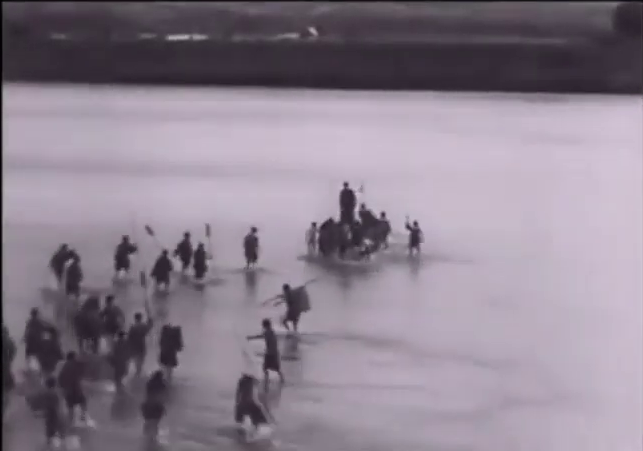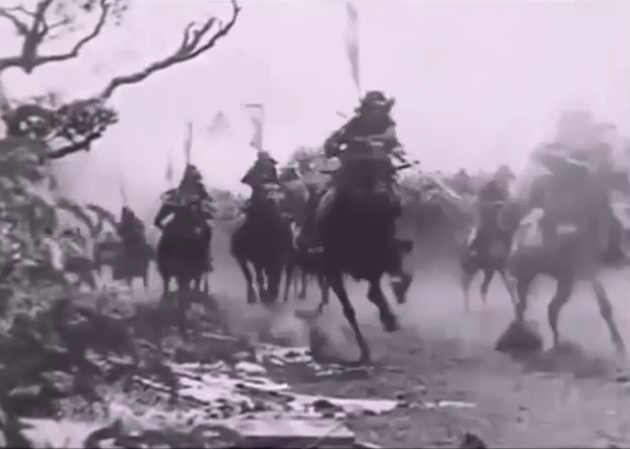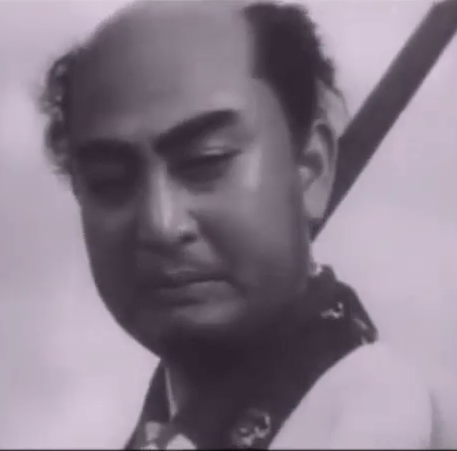Kojiki taisho provides a portrait of Matabei Goto, one of Japan’s famous warrior heroes, though it is short on actual fighting. Goto had been a great fighter and general, introduced after a battle in which he is reported to have been killed. He suddenly reappears and tells his daimyo to stage a night attack while the enemy is celebrating their victory. The lord refuses, and Goto starts a single-handed assault, but such is his reputation that the exhausted warriors follow him without orders, and the enemy is surprised and thoroughly defeated. When his lord violates a truce for peace talks, Goto becomes a ronin, the beggar general of the title.
However, his men follow him anyway. He has ordered that no servants will accompany him, but he is stopped on the road by his spear carrier, who claims that makes him an exception, then by his armorer, and before you know it he has a hundred or so exceptions. A different lord wants to take him on and thinks he has gotten a great deal, for Goto asks only for stipends for his retinue, saying he will always be taken care of by them. Only later does the lord realize he will be bankrupted by the size of the retinue and Goto goes back on the road for seventeen years.
A different lord wants to take him on and thinks he has gotten a great deal, for Goto asks only for stipends for his retinue, saying he will always be taken care of by them. Only later does the lord realize he will be bankrupted by the size of the retinue and Goto goes back on the road for seventeen years.
Stopping at a temple to pay his respects to the lord he had killed on the important 17th anniversary of his death, he meets the lord’s sister, now a nun, and the lord’s son, who has vowed revenge. But there is no duel, for Goto is on his way to Osaka castle where he promises to meet the son on the battlefield, in the proper way of a samurai. We don’t see that battle, however, perhaps because the real Goto was actually wounded at Osaka by a bullet and committed seppuku.
Though released in 1952, the movie was apparently made in 1945, which may also account for its truncated length. However, it was not released at the time due to the chaos of the months after the war and later bans by the Occupation authority. In that sense, it is similar to Kurosawa’s Men Who Tread on the Tiger’s Tale, which had a similar fate. But in every other sense, it bears no similarity to Kurosawa’s very set-bound work. Much of the movie is outdoors, on the road with Goto.  Though we see a lot of horses, however, we see no actual battle scenes, and the close-ups of Goto on horseback were obviously done with a projection screen process, just as they were even in most American Westerns of the time.
Though we see a lot of horses, however, we see no actual battle scenes, and the close-ups of Goto on horseback were obviously done with a projection screen process, just as they were even in most American Westerns of the time.
Presumably because of the original story on which it was based, the history is, shall we say, somewhat less than accurate. The precipitating event is set in 1597, almost a decade after the famous incident had really occurred, when Kuroda Yamagasa had murdered another lord at a supposed peace-making conference, killed his hostages, and crucified the maids in attendance. The movie shows Goto refusing to participate while serving lord Utsunomiya, stepping in only when swords are drawn by both sides, then quitting the lord in disgust and rescuing the hostages before they can be crucified. The new date of 1597 allows for him to meet the son and the sister who has now become a nun at the all-important 17-year-ceremony. Despite this fictionalization, it is one of the few movies I have seen in which Ieyasu Tokagawa is played by an (unidentified) actor who resembles the historical Tokugawa in age as well as general sliminess.
 Nevertheless, it is fundamentally a star vehicle for Utaemon Ichikawa, who had the most genial persona of the major chanbara stars of the thirties, whose movies from his prime have mostly disappeared. (I have thus far found only two.) He gets to do a little spear-fighting, a (very brief) bit of spear dancing, and to act noble while also seeming a bit of an all-round good guy who looks after his men and whose men are happy to look after him. Their life of near-starvation is seen as a sort of Merry Men of Sherwood without any robbery. However, he is not required to do any actual acting or any sword play.
Nevertheless, it is fundamentally a star vehicle for Utaemon Ichikawa, who had the most genial persona of the major chanbara stars of the thirties, whose movies from his prime have mostly disappeared. (I have thus far found only two.) He gets to do a little spear-fighting, a (very brief) bit of spear dancing, and to act noble while also seeming a bit of an all-round good guy who looks after his men and whose men are happy to look after him. Their life of near-starvation is seen as a sort of Merry Men of Sherwood without any robbery. However, he is not required to do any actual acting or any sword play.
Goto was a legendary Japanese epitome of the noble loser. Parts of this story may be easily confused with similar stories often told of Yukimura Sanada or Masamune Date. Of course, every nation has made films about the noble loser, but these are usually about someone sacrificing themselves for a greater cause. The movie studiously and abruptly stops before we see Goto’s noble death, so it is not encouraging the public to make a last stand. Unlike, for example, Thus the Kamikaze Blew, it is not openly propagandistic about fighting an external enemy to the last person. Unlike Dokuganryu Masamune, released in 1942,* it does not celebrate the samurai spirit. Rather it seems to mirror the state of the nation at this time by replicating the eagerness of Goto’s men to follow him, even if it means death by starvation, simply because he is their lord. The ancient roles have been reversed. A samurai lord took care of his followers from his own income, providing them stipends from his own stipend or lands provided by a greater lord. Goto will now be supported by his followers, who will sell their armor to get food for his birthday celebration or who will always give him a home out of their loyalty. It is an odd message to be sending out in 1945 or even in 1952.
The movie can be found now on YouTube under the title Beggar General.
* The horseback scenes have a definite Inagaki look about them, and since both movies were made by Daiei, it is conceivable that some of them were lifted from this earlier movie, or another similar to it that has disappeared. Film stock and horses were both growing quite precious by 1945, and even in 1952 the horses would have still been relatively rare.